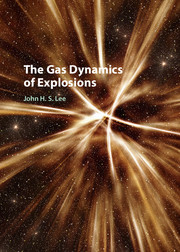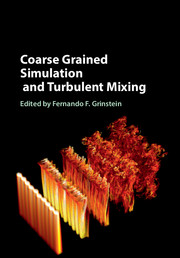Refine search
Actions for selected content:
5487 results in Thermal-fluids engineering
8 - Shock Driven Turbulence
- from Part III - Complex Mixing Consequences
-
-
- Book:
- Coarse Grained Simulation and Turbulent Mixing
- Published online:
- 05 June 2016
- Print publication:
- 30 June 2016, pp 193-231
-
- Chapter
- Export citation
Part III - Complex Mixing Consequences
-
- Book:
- Coarse Grained Simulation and Turbulent Mixing
- Published online:
- 05 June 2016
- Print publication:
- 30 June 2016, pp 191-442
-
- Chapter
- Export citation
Epilogue
- from Part III - Complex Mixing Consequences
-
-
- Book:
- Coarse Grained Simulation and Turbulent Mixing
- Published online:
- 05 June 2016
- Print publication:
- 30 June 2016, pp 432-442
-
- Chapter
- Export citation
11 - Rayleigh–Taylor Driven Turbulence
- from Part III - Complex Mixing Consequences
-
-
- Book:
- Coarse Grained Simulation and Turbulent Mixing
- Published online:
- 05 June 2016
- Print publication:
- 30 June 2016, pp 325-350
-
- Chapter
- Export citation
7 - Verification, Validation, and Uncertainty Quantification for Coarse Grained Simulation
- from Part II - Challenges
-
-
- Book:
- Coarse Grained Simulation and Turbulent Mixing
- Published online:
- 05 June 2016
- Print publication:
- 30 June 2016, pp 168-190
-
- Chapter
- Export citation
Contents
-
- Book:
- Coarse Grained Simulation and Turbulent Mixing
- Published online:
- 05 June 2016
- Print publication:
- 30 June 2016, pp vii-viii
-
- Chapter
- Export citation
Copyright page
-
- Book:
- Coarse Grained Simulation and Turbulent Mixing
- Published online:
- 05 June 2016
- Print publication:
- 30 June 2016, pp iv-iv
-
- Chapter
- Export citation
5 - Subgrid and Supergrid Modeling
- from Part II - Challenges
-
-
- Book:
- Coarse Grained Simulation and Turbulent Mixing
- Published online:
- 05 June 2016
- Print publication:
- 30 June 2016, pp 107-133
-
- Chapter
- Export citation
3 - Finite Scale Theory
- from Part I - Fundamentals
-
-
- Book:
- Coarse Grained Simulation and Turbulent Mixing
- Published online:
- 05 June 2016
- Print publication:
- 30 June 2016, pp 48-86
-
- Chapter
- Export citation
6 - Cloud Modeling
- from Part II - Challenges
-
-
- Book:
- Coarse Grained Simulation and Turbulent Mixing
- Published online:
- 05 June 2016
- Print publication:
- 30 June 2016, pp 134-167
-
- Chapter
- Export citation
2 - A Minimum Turbulence State for Coarse Grained Simulation
- from Part I - Fundamentals
-
-
- Book:
- Coarse Grained Simulation and Turbulent Mixing
- Published online:
- 05 June 2016
- Print publication:
- 30 June 2016, pp 30-47
-
- Chapter
- Export citation
Part I - Fundamentals
-
- Book:
- Coarse Grained Simulation and Turbulent Mixing
- Published online:
- 05 June 2016
- Print publication:
- 30 June 2016, pp 13-104
-
- Chapter
- Export citation
Part II - Challenges
-
- Book:
- Coarse Grained Simulation and Turbulent Mixing
- Published online:
- 05 June 2016
- Print publication:
- 30 June 2016, pp 105-190
-
- Chapter
- Export citation
13 - Combustion in Afterburning Behind Explosive Blasts
- from Part III - Complex Mixing Consequences
-
-
- Book:
- Coarse Grained Simulation and Turbulent Mixing
- Published online:
- 05 June 2016
- Print publication:
- 30 June 2016, pp 393-431
-
- Chapter
- Export citation
Dedication
-
- Book:
- Coarse Grained Simulation and Turbulent Mixing
- Published online:
- 05 June 2016
- Print publication:
- 30 June 2016, pp v-vi
-
- Chapter
- Export citation
1 - Proof of Concept
- from Part I - Fundamentals
-
-
- Book:
- Coarse Grained Simulation and Turbulent Mixing
- Published online:
- 05 June 2016
- Print publication:
- 30 June 2016, pp 15-29
-
- Chapter
- Export citation
Plate section
-
- Book:
- Coarse Grained Simulation and Turbulent Mixing
- Published online:
- 05 June 2016
- Print publication:
- 30 June 2016, pp -
-
- Chapter
- Export citation

The Gas Dynamics of Explosions
-
- Published online:
- 05 June 2016
- Print publication:
- 21 July 2016

Advanced Computational Fluid and Aerodynamics
-
- Published online:
- 05 June 2016
- Print publication:
- 15 March 2016

Coarse Grained Simulation and Turbulent Mixing
-
- Published online:
- 05 June 2016
- Print publication:
- 30 June 2016
